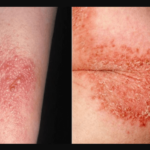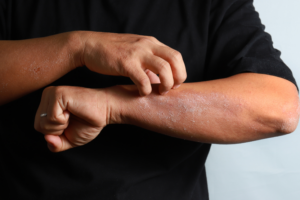Skin-to-skin contact is a method of caring for newborns where the infant is held by the parent for as many hours as possible during the day.
There are many long-term benefits of skin-to-skin contact. Skin-to-skin contact helps with the baby’s brain development, immune system, and temperature regulation. A recent study has also found that it leads to social and behavioral benefits up until their teenage years.
Read on to learn more about skin-to-skin contact and how it benefits newborns in the long term, from birth to teenage years.
History of Skin to Skin Contact
Skin-to-skin contact, also known as skin-to-skin care or kangaroo care, started in the late ’70s when Colombian mothers were encouraged to keep their premature, also known as preterm, newborns close to their bodies in order to regulate the baby’s body temperature. Many other health benefits have resulted from this phenomenon as well, and it has spread across the globe.
Since then, skin-to-skin care has been shown to be beneficial to all newborns, not just premature babies. Even in hospitals, policies are implemented that require the mother to be holding the baby for extended periods after birth. There are numerous physiological and psychological benefits to both the baby and the parents.
Sadly, preterm birth is the largest direct cause of infant mortality. The greatest risks for these deaths are infections and diseases that the baby acquires after birth, like lower respiratory tract diseases.
Long Term Benefits of Skin to Skin Contact
If skin-to-skin care is encouraged so often, that leads to the question, what is the importance of skin to skin contact for the newborn baby?
There was a study conducted by the Journal of Pediatrics that showed the benefits of skin to skin contact. Skin to skin contact, also called skin-to-skin care, has some major benefits for newborns, it turns out, from birth up until their teenage years. This is especially true for newborns that are born with a low birth weight.
Cara Wadsworth, a recent new mother who gave birth at the Utah Valley Hospital, the hospital with the largest NICU (neonatal intensive care unit) in the state, was encouraged by the hospital to give skin to skin contact to her twins.
At 20 weeks pregnant, Cara and her husband went to the hospital to determine whether they would be having a girl or boy. It came as a shock that they would be having twin girls. Her new twins, Jane and Claire, were born at 33 weeks, at 3 and 5 pounds.
Wadsworth came in every day to the NCIU to give skin to skin contact to her preemie twin girls. The twins did a great job at gaining weight (from their original low birth weight) since then, and Cara believes it was the skin to skin contact that really helped in their development.
A neonatologist at Utah Valley Regional Medical Center, Doctor Erick Gerday, said skin-to-skin care leads to many benefits for newborns and their parents. He said that for nearly a decade, the Utah Valley hospital has been promoting skin to skin contact for new mothers with their babies and analyzing the results.
It helps the mothers overcome any possible postpartum depression and improve how emotionally connected they are with their newborns. He said it also helps the mother with milk production. For the baby, skin-to-skin care helps encourage brain development, develop their immune system, and helps them better regulate their own temperature.
A recent study at the Utah Valley hospital found that there were also long-term benefits for skin to skin contact in the first hour after birth. It found there were benefits for the newborn’s social and behavioral effects as they developed into childhood and beyond into their teenage years.
The hospital is planning on promoting skin to skin contact even more now, for both mom and also dad. They encourage skin to skin in the first hour after birth, when the baby needs feeding, and other times throughout the day. Babies are talked to, sung songs, rocked, and cuddled, so they are at peace and have a better development through the whole process and beyond later in life.
Evidence-Based Practice of Skin to Skin Contact

There are other studies that show skin-to-skin care contributes to a reduction of infections and diseases in preterm babies. Researchers discovered that performing skin-to-skin care in the first week of life showed a significant reduction in neonatal mortality compared to routine incubator care.
With these beneficial outcomes for preterm babies, the studies concluded that skin-to-skin care should start earlier since the majority of neonatal deaths occur in the first few days of life.
Through the evidence-based practice of skin to skin contact, it has been shown that skin-to-skin contact reduces grimacing and crying. Up to 82% of these results show that the comfort that an infant receives during hugging significantly increases pain tolerance levels.
Another study showed full-term infants who were held for three hours after birth by their mother were found to latch onto their mother’s breasts or bare chest more often and with higher accuracy.
Breastfed infants are less likely to acquire diseases like asthma, eczema, and allergic reactions. It also leads to babies born with better blood pressure and body temperature.
A 2003 study found skin-to-skin contact immediately after birth or hours after birth decreases the stress response of an infant in response to birth. This allowed the infant to regulate their body temperature and heart rate immediately after birth and throughout their stay at the maternity ward.
Preterm infants in neonatal intensive care are kept alone and exposed to stressful interventions every day.
The mothers describe the separation as a major stressor. Not only that, the infants express a distress call that stops when they return to their mother. Evidence of animal studies has shown that rodent pups are much more sensitive to stress if they have been separated from their mothers.
There are many important factors involved in promoting healthy growth and development of full-term infants, but what about psychological development? Scientists have shown that a person’s mental health could start to be shaped just moments after birth or a few days after birth. It has been shown that skin-to-skin contact is critical to reducing stress and anxiety in the infant.
Scientists have also demonstrated, through the long-term evidence-based practice of skin to skin contact, that kangaroo care immediately after birth or hours after birth is critical in forming a healthy vagal tone. A vagal tone is a process referring to the activity of the “rest and digest” system in the body.
This system is involved in relaxation and regulating our body’s resting state. Children who are not exposed to skin-to-skin contact post-birth were described to have poorer vagal tone corresponding with heightened levels of anxiety and stress.
In a study analyzing the benefits of skin-to-skin care, the team found an improvement in mental processing and the organization of neural networks—this positively influenced learning and behavioral outcomes later in childhood.
Infants who participated in skin-to-skin care also showed an increase in brain development. Ski-to-skin increased the speed of messages sent along with networks of brain cells, unlike infants who did not. There was an improvement in communication between different brain regions.
These results were obtained with a non-invasive procedure involving the use of a magnetic field system to stimulate brain cells.
Long Term Benefits for the Parent
So there are many benefits for the baby, but what about mom or dad? What are the benefits of skin to skin contact for the parents? Mothers that practice kangaroo care reported feeling more calm, energetic, happy, and clear-headed. This is great because mothers can be at risk of postpartum depression, a form of maternal clinical depression following 10% of childbirths.
In a 2008 study with 177 new mothers, skin-to-skin care began after premature babies were discharged from the hospital, just days after birth. Mothers were encouraged to maintain frequent skin-to-skin contact with their babies at minimum periods of one to two hours at a time. The incidence of postpartum depression dropped from 37% of all study mothers to 17%.
In another study, it was found that mothers who sing during their kangaroo care sessions improved the maternal anxiety response. When the baby’s ear rests directly on the mother’s bare chest, sounds are passed through the tissue as well as through the air. This is believed to resemble the auditory environment of the mother’s womb, which is a sound all too familiar to the new bundle of joy.
All in all, kangaroo care was found to have some major benefits to the babies born to the new parents. Specifically, mothers in the kangaroo care group exhibited greater acceptance and stronger emotional closeness with their new child while still providing the temperature regulation function of an incubator.
Multiple studies show the benefits of kangaroo care, such as the reduction of stress and anxiety and even the reduction of mortality rates. This suggests that kangaroo care is an effective and safe alternative to conventional preterm baby care.
Dad benefits from skin to skin too. An interesting phenomenon is when dad spends skin to skin time with the baby. His body begins to self-regulate itself, which leads to a more stable breathing and heart rate or heartbeat rhythm. The feel-good hormone oxytocin also increases in dad throughout the skin to skin contact.
How Long Should Skin to Skin Last?

This leads us to a common question many new mothers ask: how long should skin to skin last? It is recommended to practice skin to skin contact for 60 minutes at a time. And this should be done for the first 12 weeks (approximately 3 months) or longer.
The Academy of Pediatrics gives the advice to practice skin to skin for as long as you can and as often as you can throughout the postpartum period. This postpartum period is often the first 3 months of the newborn’s life.
It is helpful if you, the mother, father, sister, brother, grandmother, or nurse, shares the skin to skin duty so that the mother is not stressed and has some time to relax. The mother is most familiar to the newborn, of course, and therefore most comforting, but other family members can fill in if necessary to make it easier for the mom.
Is It Too Late to Start Skin to Skin with Baby?
If you’re wondering, is it too late to start skin to skin with a baby? Don’t worry, it’s never too late to start skin to skin. A lot of times, the mother may not do as much skin to skin or not at all for some time as recovering from birth or distracted with visitors or other reasons.
But it is important to put your foot down, get the visitors out, and take the time for skin to skin. Even with visitors present, just put a blanket around you and your little one.
So when is a baby too old for skin-to-skin time? There is no age limit. Once a newborn has learned that his mother is present, wearing clothes might not affect the benefits of skin to skin. The ideal would be for the newborn to have skin to skin until they make it clear they don’t want it any longer.
They’ll let mom know. Even when the baby has grown, if he or she has had a stressful day, skin to skin will benefit them.
Conclusion
There are many long-term benefits of skin to skin contact for babies born today. It helps the baby develop their brain, reduce stress, develop their immune system, and better regulate their temperature. What’s more, is that skin to skin contact (also called kangaroo care) helps the baby develop social and behavioral skills into childhood and even their teenage years.
If you are about to give birth, keep this in mind and plan for skin to skin contact. It may not seem like a whole lot, but it can greatly benefit your little one for many years after birth. Take some photos of the kangaroo care time so that your loved one can thank you later when they are teenagers!



![Neutral Skin Tone Defined [and Best Colors for Neutral Skin] neutral skin tone](https://skincaregeeks.com/wp-content/uploads/2021/05/neutral-skin-tone-150x150.png)





